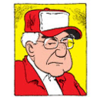US pushes for Israel-Hezbollah truce with Biden envoy's trip to Beirut
Published in News & Features
One of Joe Biden’s main Middle East envoys landed in Beirut on Tuesday, as the U.S. steps up efforts to clinch a cease-fire between Lebanese militant group Hezbollah and Israel.
Amos Hochstein, who handles Israel-Hezbollah affairs for the White House, traveled to the country to discuss a U.S.-drafted proposal to end the war between the two sides. He met Lebanon’s Prime Minister Najib Mikati and the speaker of parliament, Nabih Berri, who acts as an interlocutor between the West and Hezbollah, considered a terrorist group by the U.S. and many other countries.
His visit came after Lebanese officials signaled they were broadly behind the plan, though they’ve said there are still sticking points. Mikati had said his government had reservations about certain points in the draft and he’d discuss those with Hochstein.
After meeting Berri, Hochstein said they “continued to significantly narrow the gaps”. He hopes there’ll be a decision on a deal in the coming days.
“This is a moment of decision making,” Hochstein said. “I’m here in Beirut to facilitate that decision but it’s ultimately the decision of the parties to reach a conclusion to this conflict. It is now within our grasp.”
Depending on the progress he makes in Lebanon, Hochstein may travel to Israel next, according to an Israeli official familiar with the matter.
Biden’s administration is trying to end the conflict before handing over to President-elect Donald Trump in just over two months. U.S. officials and those within Israel see a near-term truce in Lebanon as more likely than one in Gaza, with talks between Israel and Hamas having ground to a halt.
Fighting in Lebanon is likely to continue alongside the cease-fire talks. This week, Israel’s increased air strikes on Beirut and some other parts of Lebanon. On Monday evening, Hezbollah targeted Tel Aviv with a missile. It was intercepted by the Israeli military but falling debris caused some damage and injuries in Israel’s commercial capital.
The conflict started almost 14 months ago when Hezbollah fired missiles and drones into Israel in solidarity with Hamas. Tensions escalated in September when Israel started assassinating senior Hezbollah figures, including long-standing leader Hassan Nasrallah, and then sent ground troops into southern Lebanon.
Around 2,500 people have been killed in Lebanon by Israeli strikes and the the ground offensive in the past two months, while 1.2 million — more than a fifth of the population — have been displaced. Hezbollah continues to fire on Israel daily, and about 50 Israeli troops have been killed in combat in southern Lebanon.
The cease-fire plan is based on a UN Security Council Resolution, known as 1701, that ended the last war between Israel and Hezbollah in 2006. While both Hezbollah and Israel breached the terms of the resolution, it helped keep peace between them.
Israel is insisting that, as per 1701, Hezbollah moves all its fighters back around 30 kilometers (19 miles) from the Lebanon-Israel border.
Israeli Prime Minister Benjamin Netanyahu says that’s key to enabling around 60,000 displaced people to return to their homes in the north of Israel. A similar number of civilians have had to flee southern Lebanon.
Israel also wants the right to keep striking Hezbollah positions if it deems the group to be breaching the terms of a cease-fire agreement. Both Hezbollah and the Lebanese government have said they won’t accept that. It’s unclear what the U.S. is proposing to square those positions.
Hezbollah is one of the most powerful militias in the Middle East and also a political party with substantial support among Shiite Muslims in Lebanon. The Lebanese government has little influence over the group.
—With assistance from Dan Williams and Omar Tamo.
©2024 Bloomberg L.P. Visit bloomberg.com. Distributed by Tribune Content Agency, LLC.






Comments